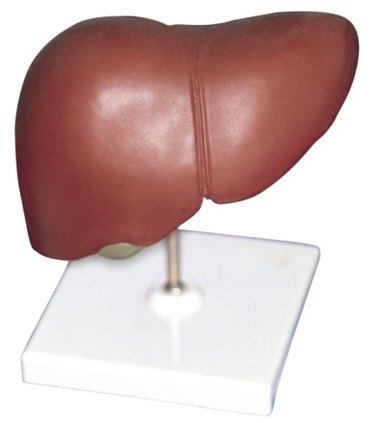
According to the Hepatitis B Foundation, your liver operates in much the same way as the engine in a car. Like an engine, your liver performs a number of functions that ensure other body processes run smoothly. Taking care of your liver is essential to helping it function properly, especially if you have liver disease. A component of good care is regular exercise, which can improve both your overall health and have a positive effect on liver function.
Types
Video of the Day
A combination of exercise types has the greatest effect on liver function. Dr. Melissa Palmer, author and practicing hepatologist, recommends an exercise program that includes aerobic exercises such as walking outside or on a treadmill, bicycling and swimming, as well as weight-bearing exercise, such as weight training.
Video of the Day
Effects
Aerobic exercise focuses on your cardiovascular system and has an effect on blood oxygenation. According to MayoClinic, aerobic exercise activities involve repetitive, large muscle movements that increase your heart rate and change your breathing pattern, increasing the amount of oxygen you take in and speeding up delivery of oxygen to vital body organs, such as your liver.
Weight training improves overall strength in both bones and muscles. Maintaining bone strength as well as muscle strength is especially important for women, as liver disease often leaves bones susceptible to osteoporosis. In addition, weight training reduces body fat, increases your lean body mass and has an effect on metabolism.
Benefits
Both types of exercise improve liver function in a number of ways. Continued aerobic exercise strengthens your heart muscle and allows it to pump blood with less effort. As this occurs, your pulse slows down and blood flow improves, making it easier for your heart to get blood to the liver and for your liver to send filtered blood back through your blood system. Building lean muscle mass through weight can delay severe muscle wasting that becomes apparent during advanced stages of liver disease. In addition, weight training prevents the buildup of excess body fat that can lead to a fatty liver and result in a medical condition called nonalcoholic steatohepatitis, or NASH. According to the National Institute of Diabetes and Digestive and Kidney Diseases, although NASH initially displays few symptoms, it can cause your liver to become nonfunctional. The NIDDK reports that as obesity becomes a greater problem in America, NASH is also becoming more common.
Time Frame
If you already have a liver condition, listen to your body when participating in any exercise program. Fatigue is a common symptom of liver disease, and you should consider this when setting exercise goals. When first getting started, Dr. Palmer recommends exercising three times a week. Each session can include 10 to 20 minutes of aerobic exercise and a few weight bearing exercises. Gradually build on this until you are exercising five or more times per week.
Considerations
It is important to make sure you stay well hydrated while exercising, especially if you have chronic hepatitis B or C or are taking the prescription medication interferon. According to Dr. Palmer, increasing your fluid intake from the typical recommendation of 64 oz. per day to 96 oz. per day is sufficient to keep your body and liver hydrated.
- Hepatitis B Foundation: Cause for a Cure
- Liver Disease: The Importance of Exercise for People with Liver Disease/Hepatitis
- MayoClinic: Aerobic Exercise: Top 10 Reasons to Get Physical
- Family Education: The Benefits of Weight Training
- National Institute of Diabetes and Digestive and Kidney Diseases: Nonalcoholic Steatohepatitis
Is this an emergency? If you are experiencing serious medical symptoms, please see the National Library of Medicine’s list of signs you need emergency medical attention or call 911.